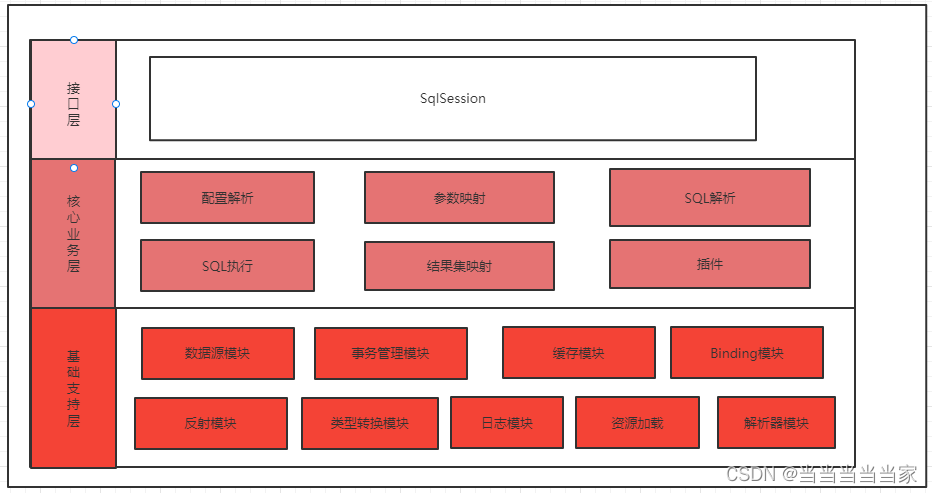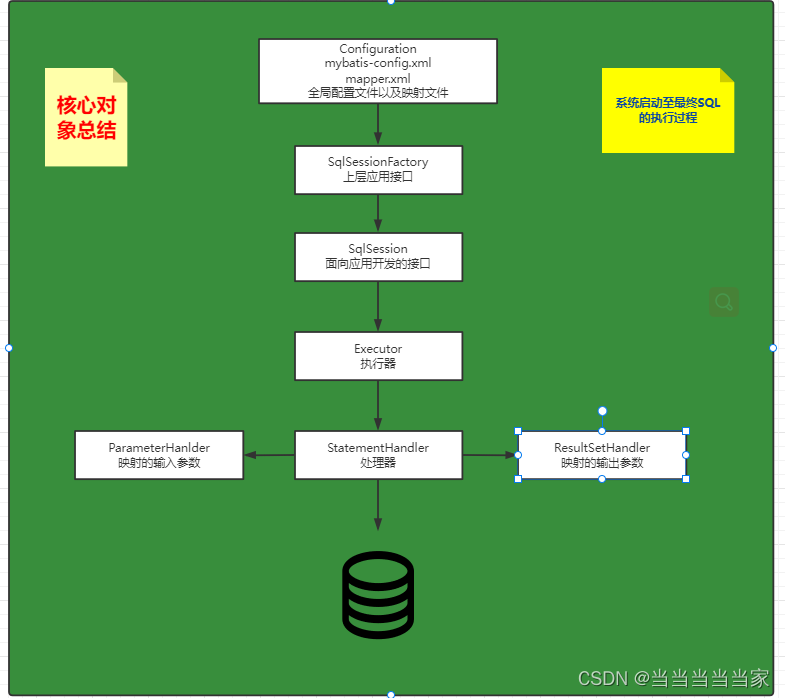前言
接下来我们就开始Mybatis的源码之旅,首先从宏观上了解Mybatis的整体框架分为三层,分别是基础支持层、核心处理层、接口层,详情看图片

接口层
接口层是开发者使用频率最多的一层,核心对象SqlSession,它是上层应用和Mybatis打交道的桥梁,SqlSession上定义了非常多的对数据库的操作方法。接口层在接收到调用请求的时候,会调用核心处理层的相应模块来完成具体的操作。
核心处理层
跟数据库操作相关的动作都是在这一层完成的,核心处理层主要做了这几件事:
- 把接口中传入的参数解析并且映射成JDBC类型
- 解析xml文件中的SQL语句,包括插入参数和动态SQL。
- 执行SQL语句。
- 处理结果集、并映射成JAVA对象
插件也属于核心层,这是由它工作方式和拦截的对象决定的。
基础支持层
基础支持层主要是一些抽取出来的通用的功能,实现复用,用来支持核心处理层的功能,比如数据源、缓存、日志、xml解析、反射、IO、事务等等。
核心流程
系统启动至最终SQL的执行过程
Mybatis的主要工作流程其实就是系统启动至最终SQL的执行过程,从构建SqlSessionFactory开始,调用Configuration用来解析全局配置和映射文件,最终生成一个新的DefaultSqlSessionFactory类。当完成SqlSessionFactory构建后,就会继续构建SqlSession,SqlSession是面向应用开发的接口,SqlSession会调用执行器Executor,Executor再调用处理器StatementHandler,StatementHandler又包括输入参数处理器ParameterHanlder以及输出参数ResultSetHandler,最终执行sql语句。

核心对象的生命周期
SqlSessionFactoryBuiler
首先是SqlSessionFactoryBuiler,它是用来构建SqlSessionFactory的,而SqlSessionFactory只需要一个,所以只要构建了这一个SqlSessionFactory,SqlSessionFactoryBuiler的流程就结束了,也没有存在的意义了,所以它的生命周期只存在于方法的局部。
SqlSessionFactory
SqlSessionFactory是用来创建SqlSession的,每次应用程序访问数据库,都需要创建一个会话。因为我们一直有创建会话的需要,所以SqlSessionFactory应该存在于应用的整个生命周期中,作用域是应用作用域。创建SqlSession只需要一个实例来做就行了,否则会产生很多的混乱和浪费资源。所以采用单例模式
SqlSession
SqlSession是一个会话,因为它是线程不安全的,不能在线程间共享。所以在请求开始的时候创建一个SqlSession对象,在请求结束或者说方法执行完毕的时候要及时关闭它。
Mapper
Mapper实际上是一个代理对象,是从SqlSession中获取的。作用是发送SQL来操作数据库的数据。它应该在一个SqlSession事务方法之内。
UserMapper mapper = sqlSession.getMapper(UserMapper.class);
SqlSessionFactory
首先我们来看下SqlSessionFactory对象的获取
SqlSessionFactory factory = new SqlSessionFactoryBuilder().build(in);
SqlSessionFactoryBuilder
首先我们new一个SqlSessionFactoryBuilder对象,这是建造者模式的运用,建造者模式用来创建复杂对象,而不需要关注内部细节,是一种封装的提现。Mybatis中很多地方用到了建造者模式。
SqlSessionFactoryBuilder用来创建SqlSessionFactory对象的方法是build(),build()方法有9个重载,可以用不同的方式来创建SqlSessionFactory对象。SqlSessionFactory对象默认是单例的。
public SqlSessionFactory build(InputStream inputStream, String environment, Properties properties) {
try {
// 用于解析 mybatis-config.xml,同时创建了 Configuration 对象 >>
XMLConfigBuilder parser = new XMLConfigBuilder(inputStream, environment, properties);
// 解析XML,最终返回一个 DefaultSqlSessionFactory >>
return build(parser.parse());
} catch (Exception e) {
throw ExceptionFactory.wrapException("Error building SqlSession.", e);
} finally {
ErrorContext.instance().reset();
try {
inputStream.close();
} catch (IOException e) {
// Intentionally ignore. Prefer previous error.
}
}
}
// 构建的代码,parser.parse()方法返回的是一个Configuration对象,build方法的如下,在这儿我们可以看到SessionFactory最终实现是DefaultSqlSessionFactory对象。
public SqlSessionFactory build(Configuration config) {
return new DefaultSqlSessionFactory(config);
}在build方法中首先是创建了一个XMLConfigBuilder对象,XMLConfigBuilder是抽象类BaseBuilder的一个子类,专门用来解析全局配置文件,针对不同的构建目标还有其他的一些子类(关联到源码路径),比如:
- XMLMapperBuilder:解析Mapper映射器
- XMLStatementBuilder:解析增删改查标签
- XMLScriptBuilder:解析动态SQL
XMLConfigBuilder
然后我们再来看看XMLConfigBuilder初始化的时候做了哪些操作
public XMLConfigBuilder(InputStream inputStream, String environment, Properties props) {
// // EntityResolver的实现类是XMLMapperEntityResolver 来完成配置文件的校验,根据对应的DTD文件来实现
this(new XPathParser(inputStream, true, props, new XMLMapperEntityResolver()), environment, props);
}再去进入重载的构造方法中
private XMLConfigBuilder(XPathParser parser, String environment, Properties props) {
// 完成了Configuration的初始化
super(new Configuration());
ErrorContext.instance().resource("SQL Mapper Configuration");
// 设置对应的Properties属性
this.configuration.setVariables(props);
// 设置 是否解析的标志为 false
this.parsed = false;
// 初始化environment
this.environment = environment;
// 初始化 解析器
this.parser = parser;
}Configuration
Configuration完成了类型别名的注册工作,通过上面的分析我们可以看到XMLConfigBuilder完成了XML文件的解析,对应XPathParse和Configuration对象的初始化操作,然后我们再来看看parse方法到底是如何解析配置文件的。
public Configuration() {
typeAliasRegistry.registerAlias("JDBC", JdbcTransactionFactory.class);
typeAliasRegistry.registerAlias("MANAGED", ManagedTransactionFactory.class);
typeAliasRegistry.registerAlias("JNDI", JndiDataSourceFactory.class);
typeAliasRegistry.registerAlias("POOLED", PooledDataSourceFactory.class);
typeAliasRegistry.registerAlias("UNPOOLED", UnpooledDataSourceFactory.class);
typeAliasRegistry.registerAlias("PERPETUAL", PerpetualCache.class);
typeAliasRegistry.registerAlias("FIFO", FifoCache.class);
typeAliasRegistry.registerAlias("LRU", LruCache.class);
typeAliasRegistry.registerAlias("SOFT", SoftCache.class);
typeAliasRegistry.registerAlias("WEAK", WeakCache.class);
typeAliasRegistry.registerAlias("DB_VENDOR", VendorDatabaseIdProvider.class);
typeAliasRegistry.registerAlias("XML", XMLLanguageDriver.class);
typeAliasRegistry.registerAlias("RAW", RawLanguageDriver.class);
typeAliasRegistry.registerAlias("SLF4J", Slf4jImpl.class);
typeAliasRegistry.registerAlias("COMMONS_LOGGING", JakartaCommonsLoggingImpl.class);
typeAliasRegistry.registerAlias("LOG4J", Log4jImpl.class);
typeAliasRegistry.registerAlias("LOG4J2", Log4j2Impl.class);
typeAliasRegistry.registerAlias("JDK_LOGGING", Jdk14LoggingImpl.class);
typeAliasRegistry.registerAlias("STDOUT_LOGGING", StdOutImpl.class);
typeAliasRegistry.registerAlias("NO_LOGGING", NoLoggingImpl.class);
typeAliasRegistry.registerAlias("CGLIB", CglibProxyFactory.class);
typeAliasRegistry.registerAlias("JAVASSIST", JavassistProxyFactory.class);
languageRegistry.setDefaultDriverClass(XMLLanguageDriver.class);
languageRegistry.register(RawLanguageDriver.class);
}parse解析
进入具体的解析方法
public Configuration parse() {
if (parsed) {
throw new BuilderException("Each XMLConfigBuilder can only be used once.");
}
parsed = true;
parseConfiguration(parser.evalNode("/configuration"));
return configuration;
}parseConfiguration方法
private void parseConfiguration(XNode root) {
try {
// issue #117 read properties first
// 对于全局配置文件各种标签的解析
propertiesElement(root.evalNode("properties"));
// 解析 settings 标签
Properties settings = settingsAsProperties(root.evalNode("settings"));
// 读取文件
loadCustomVfs(settings);
// 日志设置
loadCustomLogImpl(settings);
// 类型别名
typeAliasesElement(root.evalNode("typeAliases"));
// 插件
pluginElement(root.evalNode("plugins"));
// 用于创建对象
objectFactoryElement(root.evalNode("objectFactory"));
// 用于对对象进行加工
objectWrapperFactoryElement(root.evalNode("objectWrapperFactory"));
// 反射工具箱
reflectorFactoryElement(root.evalNode("reflectorFactory"));
// settings 子标签赋值,默认值就是在这里提供的 >>
settingsElement(settings);
// read it after objectFactory and objectWrapperFactory issue #631
// 创建了数据源 >>
environmentsElement(root.evalNode("environments"));
databaseIdProviderElement(root.evalNode("databaseIdProvider"));
typeHandlerElement(root.evalNode("typeHandlers"));
// 解析引用的Mapper映射器
mapperElement(root.evalNode("mappers"));
} catch (Exception e) {
throw new BuilderException("Error parsing SQL Mapper Configuration. Cause: " + e, e);
}
}全局配置文件解析
properties解析
private void propertiesElement(XNode context) throws Exception {
if (context != null) {
// 创建了一个 Properties 对象,后面可以用到
Properties defaults = context.getChildrenAsProperties();
String resource = context.getStringAttribute("resource");
String url = context.getStringAttribute("url");
if (resource != null && url != null) {
// url 和 resource 不能同时存在
throw new BuilderException("The properties element cannot specify both a URL and a resource based property file reference. Please specify one or the other.");
}
// 加载resource或者url属性中指定的 properties 文件
if (resource != null) {
defaults.putAll(Resources.getResourceAsProperties(resource));
} else if (url != null) {
defaults.putAll(Resources.getUrlAsProperties(url));
}
Properties vars = configuration.getVariables();
if (vars != null) {
// 和 Configuration中的 variables 属性合并
defaults.putAll(vars);
}
// 更新对应的属性信息
parser.setVariables(defaults);
configuration.setVariables(defaults);
}
}第一个是解析properties标签,读取引入的外部配置文件。这里面又有两种类型,一种是放在reource目录下的,是相对路径,一种是写的绝对路径(url)。解析的最终结果就是我们会把所有的配置信息放到名为defaults的properties对象里面,HashTable存储的。最后把XPathParser和Configuration的Properties属性都设置成我们填充后的properties对象。
settings解析
private Properties settingsAsProperties(XNode context) {
if (context == null) {
return new Properties();
}
// 获取settings节点下的所有的子节点
Properties props = context.getChildrenAsProperties();
// Check that all settings are known to the configuration class
MetaClass metaConfig = MetaClass.forClass(Configuration.class, localReflectorFactory);
for (Object key : props.keySet()) {
if (!metaConfig.hasSetter(String.valueOf(key))) {
throw new BuilderException("The setting " + key + " is not known. Make sure you spelled it correctly (case sensitive).");
}
}
return props;
}getChildrenAsProperties方法就是具体的解析了
public Properties getChildrenAsProperties() {
Properties properties = new Properties();
Iterator var2 = this.getChildren().iterator();
while(var2.hasNext()) {
XNode child = (XNode)var2.next();
// 获取对应的name和value属性
String name = child.getStringAttribute("name");
String value = child.getStringAttribute("value");
if (name != null && value != null) {
properties.setProperty(name, value);
}
}
return properties;
}loadCustomVfs(settings)方法
loadCustomVfs是获取Vitual File System的自定义实现类,比如要读取本地文件,或者FTP远程文件的时候,就可以用到自定义的VFS类。
根据settings标签里面的vfsImpl标签生成了一个抽象类VFS的子类,在Mybatis中有JBoss6VFS和DefaultVFS两个实现,在IO包中,最后赋值到Configuration中。
private void loadCustomVfs(Properties props) throws ClassNotFoundException {
String value = props.getProperty("vfsImpl");
if (value != null) {
String[] clazzes = value.split(",");
for (String clazz : clazzes) {
if (!clazz.isEmpty()) {
@SuppressWarnings("unchecked")
Class<? extends VFS> vfsImpl = (Class<? extends VFS>)Resources.classForName(clazz);
configuration.setVfsImpl(vfsImpl);
}
}
}
}loadCustomLogImpl(settings)方法
loadCustomLogImpl是根据标签获取日志的实现类,我们可以用到很多的日志的方案,包 括LOG4J,LOG4J2,SLF4J等等,在logging包中。
private void loadCustomLogImpl(Properties props) {
Class<? extends Log> logImpl = resolveClass(props.getProperty("logImpl"));
configuration.setLogImpl(logImpl);
}typeAliases解析
这一步是类型别名的解析
private void typeAliasesElement(XNode parent) {
// 放入 TypeAliasRegistry
if (parent != null) {
for (XNode child : parent.getChildren()) {
if ("package".equals(child.getName())) {
String typeAliasPackage = child.getStringAttribute("name");
configuration.getTypeAliasRegistry().registerAliases(typeAliasPackage);
} else {
String alias = child.getStringAttribute("alias");
String type = child.getStringAttribute("type");
try {
Class<?> clazz = Resources.classForName(type);
if (alias == null) {
// 扫描 @Alias 注解使用
typeAliasRegistry.registerAlias(clazz);
} else {
// 直接注册
typeAliasRegistry.registerAlias(alias, clazz);
}
} catch (ClassNotFoundException e) {
throw new BuilderException("Error registering typeAlias for '" + alias + "'. Cause: " + e, e);
}
}
}
}
}plugins解析
插件标签的解析
private void pluginElement(XNode parent) throws Exception {
if (parent != null) {
for (XNode child : parent.getChildren()) {
// 获取<plugin> 节点的 interceptor 属性的值
String interceptor = child.getStringAttribute("interceptor");
// 获取<plugin> 下的所有的properties子节点
Properties properties = child.getChildrenAsProperties();
// 获取 Interceptor 对象
Interceptor interceptorInstance = (Interceptor) resolveClass(interceptor).getDeclaredConstructor().newInstance();
// 设置 interceptor的 属性
interceptorInstance.setProperties(properties);
// Configuration中记录 Interceptor
configuration.addInterceptor(interceptorInstance);
}
}
}objectFactoryElement,objectWrapperFactoryElement及reflectorFactoryElement解析
private void objectFactoryElement(XNode context) throws Exception {
if (context != null) {
// 获取<objectFactory> 节点的 type 属性
String type = context.getStringAttribute("type");
// 获取 <objectFactory> 节点下的配置信息
Properties properties = context.getChildrenAsProperties();
// 获取ObjectFactory 对象的对象 通过反射方式
ObjectFactory factory = (ObjectFactory) resolveClass(type).getDeclaredConstructor().newInstance();
// ObjectFactory 和 对应的属性信息关联
factory.setProperties(properties);
// 将创建的ObjectFactory对象绑定到Configuration中
configuration.setObjectFactory(factory);
}
}
private void objectWrapperFactoryElement(XNode context) throws Exception {
if (context != null) {
String type = context.getStringAttribute("type");
ObjectWrapperFactory factory = (ObjectWrapperFactory) resolveClass(type).getDeclaredConstructor().newInstance();
configuration.setObjectWrapperFactory(factory);
}
}
private void reflectorFactoryElement(XNode context) throws Exception {
if (context != null) {
String type = context.getStringAttribute("type");
ReflectorFactory factory = (ReflectorFactory) resolveClass(type).getDeclaredConstructor().newInstance();
configuration.setReflectorFactory(factory);
}
}ObjectFactory用来创建返回的对象,ObjectWrapperFactory用来对对象做特殊的处理。比如;select 没有写别名,查询返回的是一个Map,可以在自定义的objectWrapperFactory中把下划线命名变成驼峰名。
ReflectorFactory是反射的工具箱,对反射的操作进行了封装,以上对象都是用resolveClass创建的。
settingsElement(settings)方法
这里是对settings标签里面所以子标签的处理,前面我们已经把子标签全部转换成了Properties对象,所以在这里处理Properties对象就可以了。
settings二级标签中一共26个配置,比如二级缓存、延迟加载、默认执行器类型等等。
需要注意的是。settings里面的默认值都是在这里赋值的
private void settingsElement(Properties props) {
configuration.setAutoMappingBehavior(AutoMappingBehavior.valueOf(props.getProperty("autoMappingBehavior", "PARTIAL")));
configuration.setAutoMappingUnknownColumnBehavior(AutoMappingUnknownColumnBehavior.valueOf(props.getProperty("autoMappingUnknownColumnBehavior", "NONE")));
configuration.setCacheEnabled(booleanValueOf(props.getProperty("cacheEnabled"), true));
configuration.setProxyFactory((ProxyFactory) createInstance(props.getProperty("proxyFactory")));
configuration.setLazyLoadingEnabled(booleanValueOf(props.getProperty("lazyLoadingEnabled"), false));
configuration.setAggressiveLazyLoading(booleanValueOf(props.getProperty("aggressiveLazyLoading"), false));
configuration.setMultipleResultSetsEnabled(booleanValueOf(props.getProperty("multipleResultSetsEnabled"), true));
configuration.setUseColumnLabel(booleanValueOf(props.getProperty("useColumnLabel"), true));
configuration.setUseGeneratedKeys(booleanValueOf(props.getProperty("useGeneratedKeys"), false));
configuration.setDefaultExecutorType(ExecutorType.valueOf(props.getProperty("defaultExecutorType", "SIMPLE")));
configuration.setDefaultStatementTimeout(integerValueOf(props.getProperty("defaultStatementTimeout"), null));
configuration.setDefaultFetchSize(integerValueOf(props.getProperty("defaultFetchSize"), null));
configuration.setDefaultResultSetType(resolveResultSetType(props.getProperty("defaultResultSetType")));
configuration.setMapUnderscoreToCamelCase(booleanValueOf(props.getProperty("mapUnderscoreToCamelCase"), false));
configuration.setSafeRowBoundsEnabled(booleanValueOf(props.getProperty("safeRowBoundsEnabled"), false));
configuration.setLocalCacheScope(LocalCacheScope.valueOf(props.getProperty("localCacheScope", "SESSION")));
configuration.setJdbcTypeForNull(JdbcType.valueOf(props.getProperty("jdbcTypeForNull", "OTHER")));
configuration.setLazyLoadTriggerMethods(stringSetValueOf(props.getProperty("lazyLoadTriggerMethods"), "equals,clone,hashCode,toString"));
configuration.setSafeResultHandlerEnabled(booleanValueOf(props.getProperty("safeResultHandlerEnabled"), true));
configuration.setDefaultScriptingLanguage(resolveClass(props.getProperty("defaultScriptingLanguage")));
configuration.setDefaultEnumTypeHandler(resolveClass(props.getProperty("defaultEnumTypeHandler")));
configuration.setCallSettersOnNulls(booleanValueOf(props.getProperty("callSettersOnNulls"), false));
configuration.setUseActualParamName(booleanValueOf(props.getProperty("useActualParamName"), true));
configuration.setReturnInstanceForEmptyRow(booleanValueOf(props.getProperty("returnInstanceForEmptyRow"), false));
configuration.setLogPrefix(props.getProperty("logPrefix"));
configuration.setConfigurationFactory(resolveClass(props.getProperty("configurationFactory")));
configuration.setShrinkWhitespacesInSql(booleanValueOf(props.getProperty("shrinkWhitespacesInSql"), false));
configuration.setDefaultSqlProviderType(resolveClass(props.getProperty("defaultSqlProviderType")));
}environmentsElement解析
这一步是解析environments标签,一个environment就是对应一个数据源,所以在这里我们会根据配置的 创建一个事务工厂,根据标签创建一个数据源,最后把这两个对 象设置成Environment对象的属性,放到Configuration里面。
private void environmentsElement(XNode context) throws Exception {
if (context != null) {
if (environment == null) {
environment = context.getStringAttribute("default");
}
for (XNode child : context.getChildren()) {
String id = child.getStringAttribute("id");
if (isSpecifiedEnvironment(id)) {
// 事务工厂
TransactionFactory txFactory = transactionManagerElement(child.evalNode("transactionManager"));
// 数据源工厂(例如 DruidDataSourceFactory )
DataSourceFactory dsFactory = dataSourceElement(child.evalNode("dataSource"));
// 数据源
DataSource dataSource = dsFactory.getDataSource();
// 包含了 事务工厂和数据源的 Environment
Environment.Builder environmentBuilder = new Environment.Builder(id)
.transactionFactory(txFactory)
.dataSource(dataSource);
// 放入 Configuration
configuration.setEnvironment(environmentBuilder.build());
break;
}
}
}
}databaseIdProviderElement方法
解析databaseIdProvider标签,生成DatabaseIdProvider对象(用来支持不同厂商的数据库)。
private void databaseIdProviderElement(XNode context) throws Exception {
DatabaseIdProvider databaseIdProvider = null;
if (context != null) {
String type = context.getStringAttribute("type");
// awful patch to keep backward compatibility
if ("VENDOR".equals(type)) {
type = "DB_VENDOR";
}
Properties properties = context.getChildrenAsProperties();
databaseIdProvider = (DatabaseIdProvider) resolveClass(type).getDeclaredConstructor().newInstance();
databaseIdProvider.setProperties(properties);
}
Environment environment = configuration.getEnvironment();
if (environment != null && databaseIdProvider != null) {
String databaseId = databaseIdProvider.getDatabaseId(environment.getDataSource());
configuration.setDatabaseId(databaseId);
}
}typeHandlerElement 方法
跟TypeAlias一样,TypeHandler有两种配置方式,一种是单独配置一个类,一种是指定一个package。 最后我们得到的是JavaType和JdbcType,以及用来做相互映射的TypeHandler之间的映射关系,存放在 TypeHandlerRegistry对象里面。
private void typeHandlerElement(XNode parent) {
if (parent != null) {
for (XNode child : parent.getChildren()) {
if ("package".equals(child.getName())) {
String typeHandlerPackage = child.getStringAttribute("name");
typeHandlerRegistry.register(typeHandlerPackage);
} else {
String javaTypeName = child.getStringAttribute("javaType");
String jdbcTypeName = child.getStringAttribute("jdbcType");
String handlerTypeName = child.getStringAttribute("handler");
Class<?> javaTypeClass = resolveClass(javaTypeName);
JdbcType jdbcType = resolveJdbcType(jdbcTypeName);
Class<?> typeHandlerClass = resolveClass(handlerTypeName);
if (javaTypeClass != null) {
if (jdbcType == null) {
typeHandlerRegistry.register(javaTypeClass, typeHandlerClass);
} else {
typeHandlerRegistry.register(javaTypeClass, jdbcType, typeHandlerClass);
}
} else {
typeHandlerRegistry.register(typeHandlerClass);
}
}
}
}
}mapperElement方法,mapper解析
mapper解析,根据全局配置文件中不同的注册方式,用不同的方法扫描,但最终都是做了两件事情,对于语句的注册和接口的注册
| 扫描类型 | 含义 |
| resource | 相对路径 |
| url | 绝对路径 |
| package | 包 |
| class | 单个接口 |
private void mapperElement(XNode parent) throws Exception {
if (parent != null) {
for (XNode child : parent.getChildren()) {
// 不同的定义方式的扫描,最终都是调用 addMapper()方法(添加到 MapperRegistry)。这个方法和 getMapper() 对应
// package 包
if ("package".equals(child.getName())) {
String mapperPackage = child.getStringAttribute("name");
configuration.addMappers(mapperPackage);
} else {
String resource = child.getStringAttribute("resource");
String url = child.getStringAttribute("url");
String mapperClass = child.getStringAttribute("class");
if (resource != null && url == null && mapperClass == null) {
// resource 相对路径
ErrorContext.instance().resource(resource);
try(InputStream inputStream = Resources.getResourceAsStream(resource)) {
XMLMapperBuilder mapperParser = new XMLMapperBuilder(inputStream, configuration, resource, configuration.getSqlFragments());
// 解析 Mapper.xml,总体上做了两件事情
mapperParser.parse();
}
} else if (resource == null && url != null && mapperClass == null) {
// url 绝对路径
ErrorContext.instance().resource(url);
try(InputStream inputStream = Resources.getUrlAsStream(url)){
XMLMapperBuilder mapperParser = new XMLMapperBuilder(inputStream, configuration, url, configuration.getSqlFragments());
mapperParser.parse();
}
} else if (resource == null && url == null && mapperClass != null) {
// class 单个接口
Class<?> mapperInterface = Resources.classForName(mapperClass);
configuration.addMapper(mapperInterface);
} else {
throw new BuilderException("A mapper element may only specify a url, resource or class, but not more than one.");
}
}
}
}
}映射文件的解析
首先进入parse方法
public void parse() {
// 总体上做了两件事情,对于语句的注册和接口的注册
if (!configuration.isResourceLoaded(resource)) {
// 1、具体增删改查标签的解析。
// 一个标签一个MappedStatement。 >
configurationElement(parser.evalNode("/mapper"));
configuration.addLoadedResource(resource);
// 2、把namespace(接口类型)和工厂类绑定起来,放到一个map。
// 一个namespace 一个 MapperProxyFactory >>
bindMapperForNamespace();
}
parsePendingResultMaps();
parsePendingCacheRefs();
parsePendingStatements();
}configurationElement()——解析所有的子标签,最终获得MappedStatement对象。bindMapperForNamespace()——把namespace(接口类型)和工厂类MapperProxyFactory绑定起来。
configurationElement方法
configurationElement是对Mapper.xml中所有具体的标签的解析,包括namespace、cache、 parameterMap、resultMap、sql和select|insert|update|delete。
private void configurationElement(XNode context) {
try {
String namespace = context.getStringAttribute("namespace");
if (namespace == null || namespace.isEmpty()) {
throw new BuilderException("Mapper's namespace cannot be empty");
}
builderAssistant.setCurrentNamespace(namespace);
// 添加缓存对象
cacheRefElement(context.evalNode("cache-ref"));
// 解析 cache 属性,添加缓存对象
cacheElement(context.evalNode("cache"));
// 创建 ParameterMapping 对象
parameterMapElement(context.evalNodes("/mapper/parameterMap"));
// 创建 List<ResultMapping>
resultMapElements(context.evalNodes("/mapper/resultMap"));
// 解析可以复用的SQL
sqlElement(context.evalNodes("/mapper/sql"));
// 解析增删改查标签,得到 MappedStatement >>
buildStatementFromContext(context.evalNodes("select|insert|update|delete"));
} catch (Exception e) {
throw new BuilderException("Error parsing Mapper XML. The XML location is '" + resource + "'. Cause: " + e, e);
}
}在buildStatementFromContext()方法中,创建了用来解析增删改查标签的XMLStatementBuilder,并 且把创建的MappedStatement添加到mappedStatements中。
private void buildStatementFromContext(List<XNode> list) {
if (configuration.getDatabaseId() != null) {
buildStatementFromContext(list, configuration.getDatabaseId());
}
buildStatementFromContext(list, null);
}
private void buildStatementFromContext(List<XNode> list, String requiredDatabaseId) {
for (XNode context : list) {
final XMLStatementBuilder statementParser = new XMLStatementBuilder(configuration, builderAssistant, context, requiredDatabaseId);
try {
statementParser.parseStatementNode();
} catch (IncompleteElementException e) {
configuration.addIncompleteStatement(statementParser);
}
}
}bindMapperForNamespace方法
private void bindMapperForNamespace() {
String namespace = builderAssistant.getCurrentNamespace();
if (namespace != null) {
Class<?> boundType = null;
try {
// 根据名称空间加载对应的接口类型
boundType = Resources.classForName(namespace);
} catch (ClassNotFoundException e) {
// ignore, bound type is not required
}
if (boundType != null && !configuration.hasMapper(boundType)) {
// Spring may not know the real resource name so we set a flag
// to prevent loading again this resource from the mapper interface
// look at MapperAnnotationBuilder#loadXmlResource
configuration.addLoadedResource("namespace:" + namespace);
// 添加到 MapperRegistry,本质是一个 map,里面也有 Configuration >>
configuration.addMapper(boundType);
}
}
}通过源码分析发现主要是是调用了addMapper()。addMapper()方法中,把接口类型注册到 MapperRegistry中:实际上是为接口创建一个对应的MapperProxyFactory(用于为这个type提供工厂 类,创建MapperProxy)。
public <T> void addMapper(Class<T> type) {
// 检测 type 是否为接口
if (type.isInterface()) {
// 检测是否已经加装过该接口
if (hasMapper(type)) {
throw new BindingException("Type " + type + " is already known to the MapperRegistry.");
}
boolean loadCompleted = false;
try {
// !Map<Class<?>, MapperProxyFactory<?>> 存放的是接口类型,和对应的工厂类的关系
knownMappers.put(type, new MapperProxyFactory<>(type));
// It's important that the type is added before the parser is run
// otherwise the binding may automatically be attempted by the
// mapper parser. If the type is already known, it won't try.
// 注册了接口之后,根据接口,开始解析所有方法上的注解,例如 @Select >>
MapperAnnotationBuilder parser = new MapperAnnotationBuilder(config, type);
parser.parse();
loadCompleted = true;
} finally {
if (!loadCompleted) {
knownMappers.remove(type);
}
}
}
}同样的再进入parse方法查看
public void parse() {
String resource = type.toString();
if (!configuration.isResourceLoaded(resource)) {
// 先判断 Mapper.xml 有没有解析,没有的话先解析 Mapper.xml(例如定义 package 方式)
loadXmlResource();
configuration.addLoadedResource(resource);
assistant.setCurrentNamespace(type.getName());
// 处理 @CacheNamespace
parseCache();
// 处理 @CacheNamespaceRef
parseCacheRef();
// 获取所有方法
for (Method method : type.getMethods()) {
if (!canHaveStatement(method)) {
continue;
}
if (getAnnotationWrapper(method, false, Select.class, SelectProvider.class).isPresent()
&& method.getAnnotation(ResultMap.class) == null) {
// 解析方法上的注解,添加到 MappedStatement 集合中 >>
parseResultMap(method);
}
try {
parseStatement(method);
} catch (IncompleteElementException e) {
configuration.addIncompleteMethod(new MethodResolver(this, method));
}
}
}
parsePendingMethods();
}大家可以继续进入到parseStatement方法中查看。
总结:
- 我们主要完成了config配置文件、Mapper文件、Mapper接口中注解的解析
- 我们得到了一个最重要的对象Configuration,这里面存放了全部的配置信息,在它的属性里还有各种各样的容器
- 最后返回了一个DefaultSqlSessionFactory,里面持有了Configuration的实例
最后时序图






















 939
939











 被折叠的 条评论
为什么被折叠?
被折叠的 条评论
为什么被折叠?








